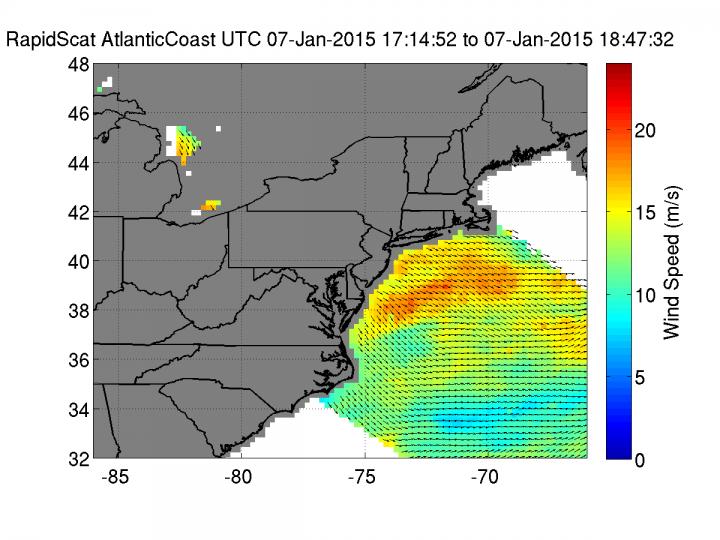NASA's ISS-RapidScat looks at the winds in US east coast's 'wind chill'

NASA's RapidScat saw sustained sustained winds between 15 mps/33.5 mph/54 kph (yellow) to 20 meters per second/44.7 mph/72 kph (red). When outside air temperatures are near 15F (-9.4C), a 15 mph (24.1 kph) wind will make the wind chill 0F (-18C). Credit: NASA/JPL, Doug Tyler
Residents along the northeastern and Mid-Atlantic coast of the U.S. started experiencing bitter wind chills on January 7, 2015 as ISS-RapidScat measured coastal winds from its perch aboard the International Space Station or ISS. Those wind chills continued on January 8.
The ISS-RapidScat instrument flies aboard the International Space Station and measures Earth's ocean surface wind speed and direction. ISS-RapidScat images are created by Analyst Doug Tyler at NASA's Jet Propulsion Laboratory (JPL) in Pasadena, California. NASA JPL manages ISS-RapidScat.
Between 17:14 UTC (12:14 p.m. EST) and 18:47 UTC (1:47 p.m. EST) on January 7, ISS-RapidScat measured high wind speeds over the Atlantic Ocean just off-shore from the northeastern and Mid-Atlantic states. The winds were sustained between 15 meters per second/33.5 mph/54 kph to 20 meters per second/44.7 mph/72 kph. When outside air temperatures are near 15F (-9.4C), a 15 mph (24.1 kph) wind will make the wind chill 0F (-18C).
On Thursday, January 8, 2015, NOAA's National Weather Service Weather Prediction Center in College Park, Maryland noted that air temperatures will be 20 to 25 degrees below average from the Tennessee Valley to the Mid-Atlantic. Wind chill values will be near zero in Portland, Maine, Boston, Massachusetts, and New York City during the day and night of January 8. As far south as Norfolk, Virginia, wind chills will be in the teens during the day and at night.
The National Weather Service defines wind chill as the term used to describe the rate of heat loss on the body (humans and animals) resulting from the combined effect of low temperature and wind. As winds increase, heat is carried away from the body at a faster rate, driving down both the skin temperature and eventually the internal body temperature. For the NWS wind chill chart, visit: http://www.
ISS-RapidScat is a partnership between JPL and the International Space Station Program Office at NASA's Johnson Space Center, Houston, with support from the Earth Science Division of NASA's Science Mission Directorate, Washington. Other ongoing mission partners include NASA's Marshall Space Flight Center, Huntsville, Alabama; and the European Space Agency.
For more information about ISS-RapidScat, visit: http://winds.
For more information about NASA's Earth science activities in 2015, visit: http://www.
Media Contact
All latest news from the category: Earth Sciences
Earth Sciences (also referred to as Geosciences), which deals with basic issues surrounding our planet, plays a vital role in the area of energy and raw materials supply.
Earth Sciences comprises subjects such as geology, geography, geological informatics, paleontology, mineralogy, petrography, crystallography, geophysics, geodesy, glaciology, cartography, photogrammetry, meteorology and seismology, early-warning systems, earthquake research and polar research.
Newest articles

High-energy-density aqueous battery based on halogen multi-electron transfer
Traditional non-aqueous lithium-ion batteries have a high energy density, but their safety is compromised due to the flammable organic electrolytes they utilize. Aqueous batteries use water as the solvent for…

First-ever combined heart pump and pig kidney transplant
…gives new hope to patient with terminal illness. Surgeons at NYU Langone Health performed the first-ever combined mechanical heart pump and gene-edited pig kidney transplant surgery in a 54-year-old woman…

Biophysics: Testing how well biomarkers work
LMU researchers have developed a method to determine how reliably target proteins can be labeled using super-resolution fluorescence microscopy. Modern microscopy techniques make it possible to examine the inner workings…





















